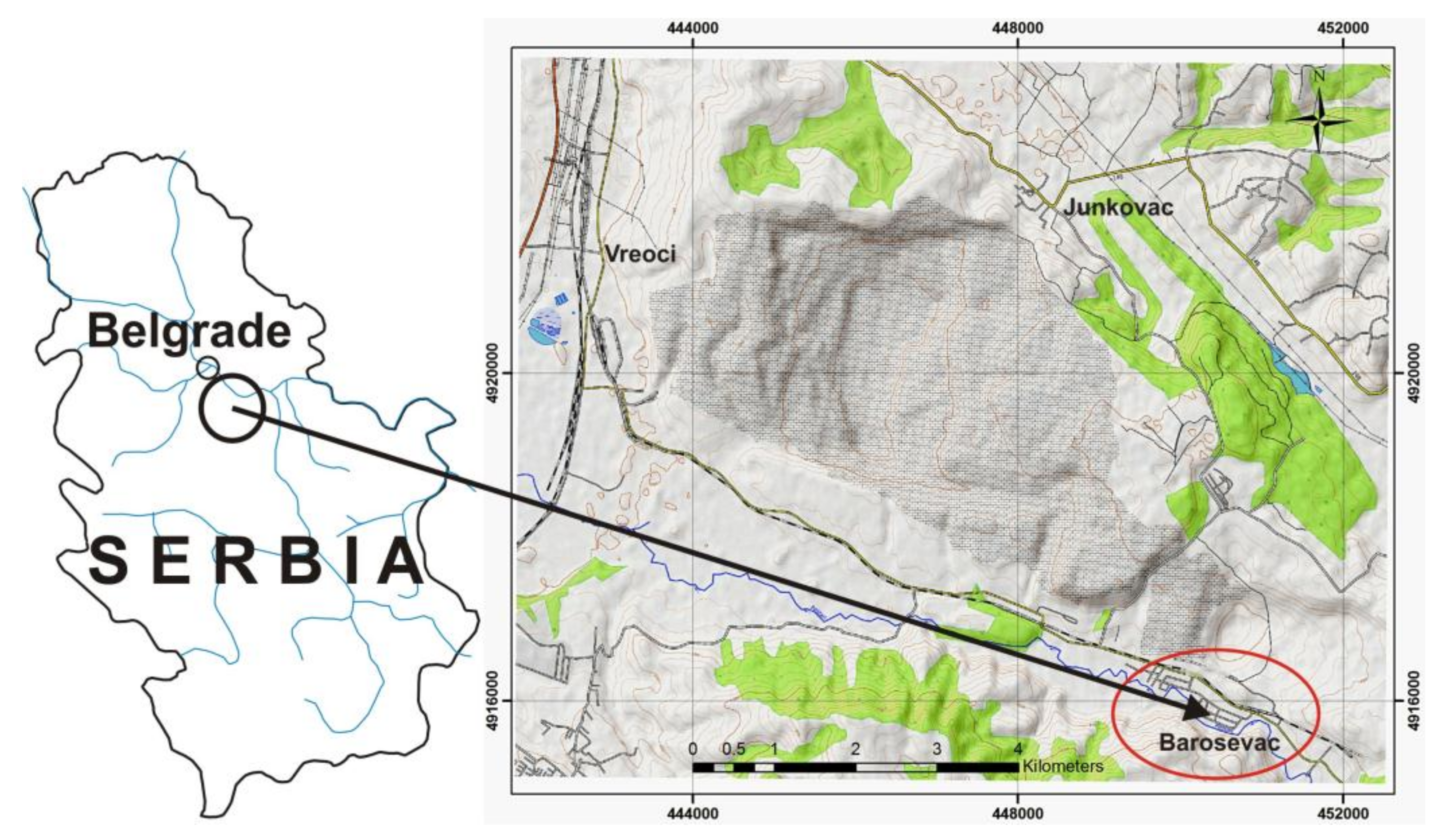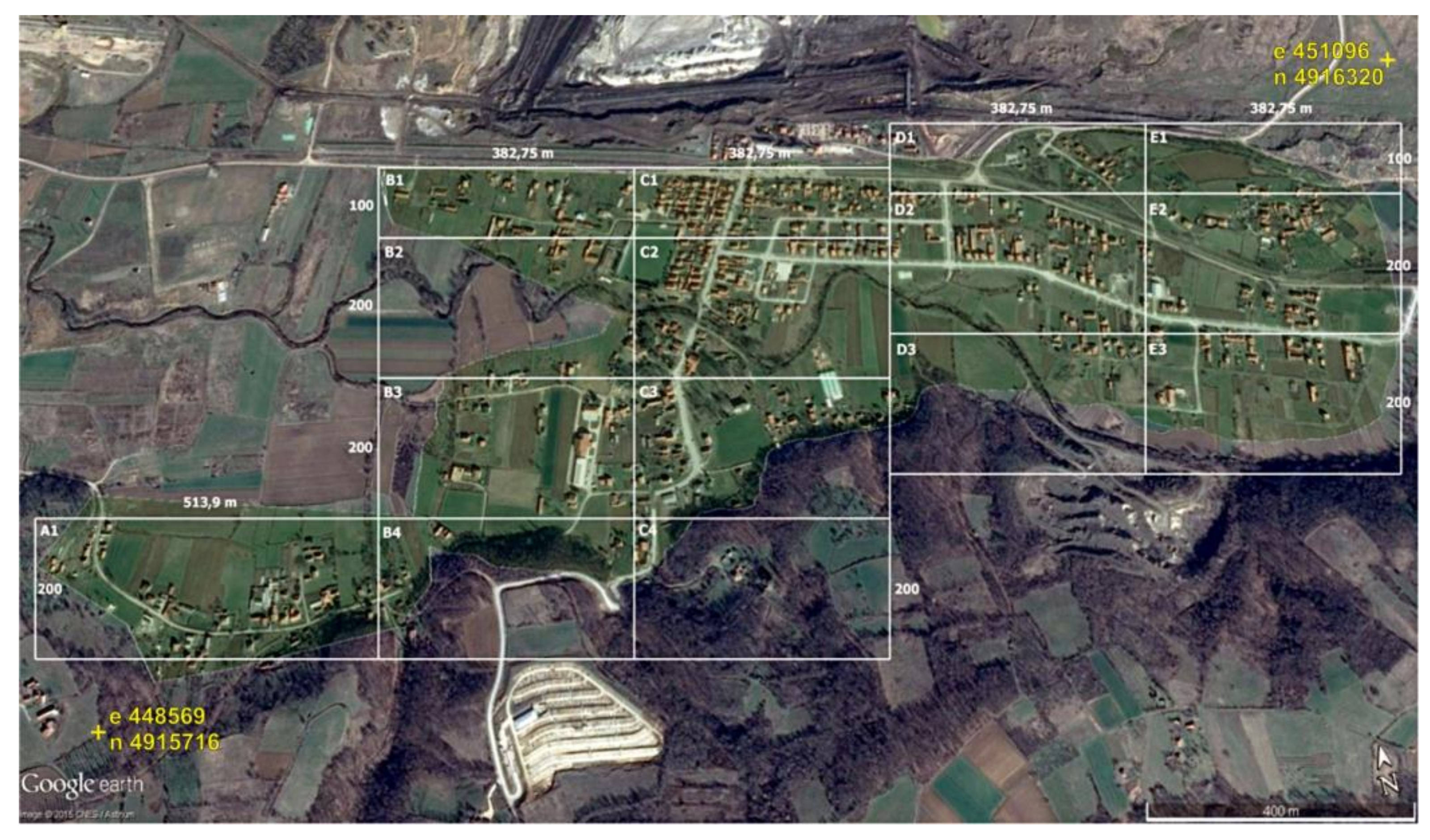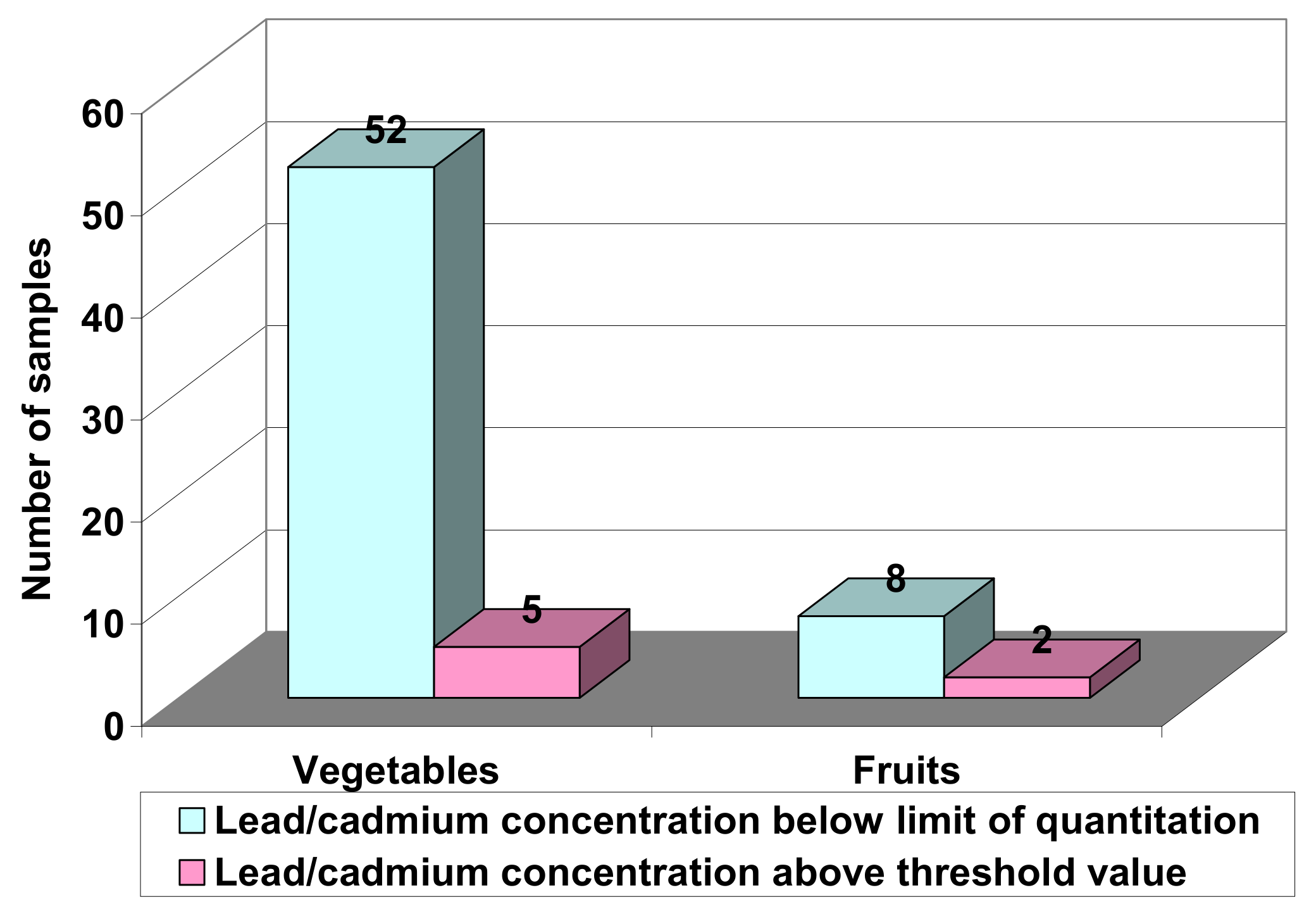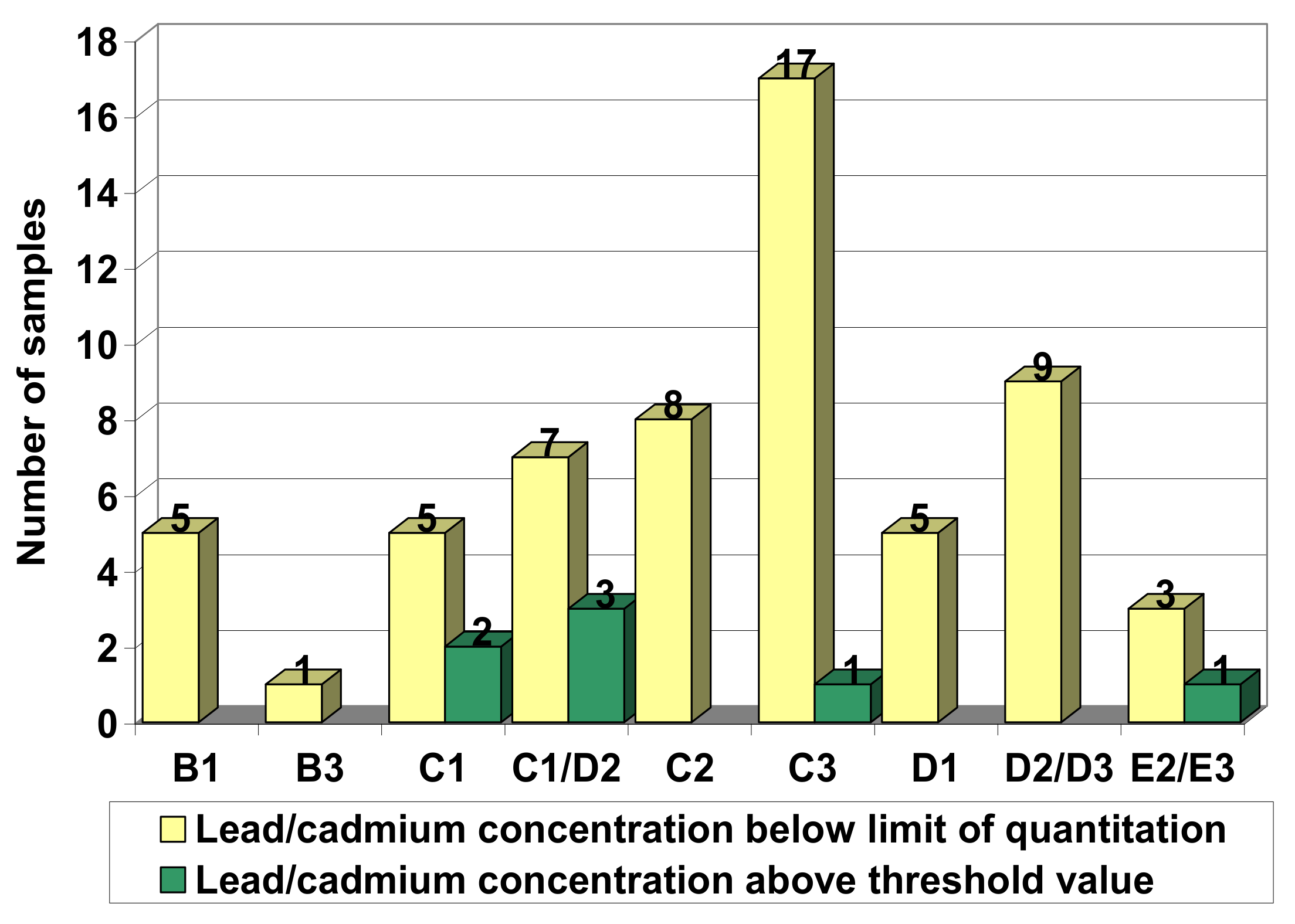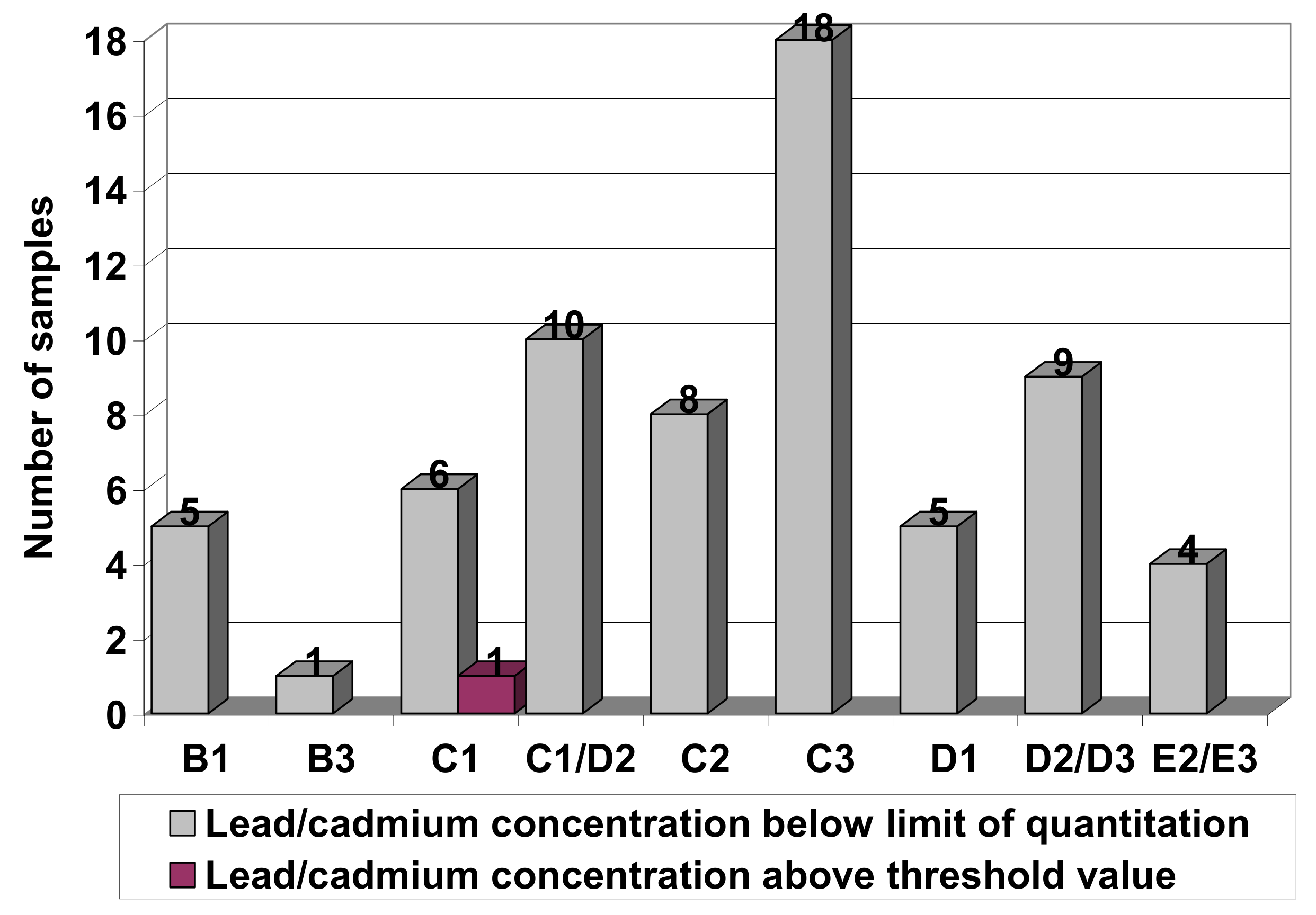1. Introduction
Generally speaking, the problem of the quality of agricultural produce is becoming a problem on a global level. Urban and industrial centres, mines, large landfills, etc., have a direct impact on people living in their surroundings, and also an indirect impact, through food produced in the wider environment of these large sources of pollution, when consumed by people from the same locality or when it gets to the market. In this way, contaminated food, that has not been tested, can enter every household and have a significant impact on human health. In the wider scientific and professional public, a lot has been written about the consequences that a person who has spent a longer period of time exposed to contaminated food can face. Likewise, worldwide, in the wider environment of large sources of pollution, soil and produce analyses have been launched in order to attract public attention, as well as to inform the population living nearby about the hazards to which they are exposed.
For example, in the Tongling Mining area of China, the hazard index (HI) was more than 1 for the consumption of vegetables for both adults and children [
1]. Zhou et al. [
2] investigated heavy metal accumulation in 22 vegetable species in order to assess the human health risks of vegetable consumption. Taghipour and Maseferi Mosaferi [
3] indicate the importance of monitoring the levels of heavy metals in vegetables in providing useful information for promoting food safety. A number of works [
4,
5,
6,
7,
8,
9,
10] about heavy metals in the agricultural soils of the European Union and around the world and their implications for food safety have been written and published.
Can contemporary mining respond to the complex challenges of sustainable development, a concept increasingly seen as a solution for numerous problems created by the ongoing development of societies? This question is often raised by mining professionals and not only them.
Strictly speaking, it is difficult to harmonize the main postulates of the mineral industry with sustainable development.
Global warming, atmospheric pollution, and the degradation and pollution of soil and water are indisputable adverse effects of industrial activity and contemporary economies, in which mining has a not-so-small role.
Accelerating economic development worldwide and population growth are increasing the demand for mineral resources. The status and role of the mineral industry today are such that it is safe to conclude that on a global scale there are no adequate substitutes for its products.
The use of fossil fuels, particularly coal, is an especially delicate issue. It is well-known that the effects of burning coal are extremely harmful. Still, it is a fact that about 42% of the global energy supply is provided by burning coal. The percentage in Serbia is even larger.
The main supplier of coal in Serbia is the Kolubara Coal Basin in Lazarevac. This mining company produces about 30 million tons of lignite coal and some 70 million tons of overburden annually, of which 1.2 million tons of lignite coal is delivered to the consumer market. The Kolubara Coal Basin (KCB) operates within the Electric Power Industry of Serbia and (a) provides 70% of its coal output; which (b) takes 70% of its coal output. KCB’s share in Serbia’s overall energy balance is 52%, and coal is used to generate more than 20 billion kW·h [
11].
Consequently, it is clear that the KCB is extremely important for Serbia’s economy.
Given the social, economic, and manufacturing circumstances, it can easily be concluded that in the foreseeable future coal will remain the backbone of Serbia’s power supply.
However, the production and burning of coal are a nightmare for all those involved in environmental protection, and not only them. To rephrase the earlier question: Is it possible to fully implement the concept of sustainable development in such circumstances?
The present paper does not aim to provide the final answer to this question. Instead, it presents the results of research on toxic metals in produce sampled from gardens in the immediate vicinity of open-pit coal mines, to draw attention to the need to examine the effect of mining on the environment. Only valid data and unbiased assessments will lead to an answer that is important to all those associated in any way with the mining industry.
2. Toxic Metals in Soils and Food
The origin of heavy, toxic metals in soils and food is either natural or anthropogenic. Anthropogenic drivers are associated with contamination during the course of farming, packaging, transporting, and processing produce. The toxic metals most often encountered are lead, cadmium, and arsenic.
The presence of these heavy metals in the human body affects bodily functions, causes various ailments, and may even lead to death [
12].
According to Goldschmidt [
13], lead, like cadmium, is a chalcophile element. Hydrothermal deposits of non-ferrous ores are its primary natural sources. Lead is generally associated with zinc (and copper). Galenite is the main lead mineral ore. There are also many other minerals, among which sulfosalts are the most interesting from the perspective of mineral ore exploration. In the atmosphere, lead is transformed into cerussite (lead carbonate) as well as some other minerals [
14]. Lead has been in use since 7000 BC [
15]. Ancient Rome used lead to fabricate water piping because of its resistance to corrosion. As a white pigment, it has been extensively used as the carbonate compound 2PbCO
3·Pb(OH)
2, and also as a brownish-red paint to protect iron. Today, the largest amounts of lead are probably used in car batteries. Lead is also a common ingredient in gloss finishes in the ceramic industry.
In a natural environment, elevated concentrations of lead are often caused by mining operations, paints (especially if combusted), deposols originating from industrial facilities, ceramic waste, batteries, tetraethyl leaded gasoline, and piping joined with lead. It occurs in the air in the form of halides, and in water as colloidal particles of lead carbonate, lead oxide, lead hydroxide, etc. [
16,
17].
In rare cases, cadmium poisoning is lethal. Chronic exposure and intake of this metal over a protracted period of time is a health hazard [
18]. It has been found to interfere with the cellular zinc balance. The absence of zinc or lack of iron in the body tends to enhance cadmium absorption [
18,
19]. Cadmium is carcinogenic [
18,
19,
20,
21,
22].
Cadmium is toxic, and poisoning can occur even if present in traces. One of the widely reported cases is the itai-itai disease outbreak caused by cadmium poisoning in the Japanese Tojama Prefecture [
23], which began in 1912 near mining operations (non-ferrous metals) and was recognized as such by the Japanese Ministry of Health in 1968 [
24]. Cadmium had reached watercourses from the mines, tailing ponds, and ore processing plants. The symptoms of the disease are severe pain and spine/joint disorders.
The toxic metal most often found in food is mercury. It does not have a single positive effect on human metabolism, and its impact on the distribution and retention of other heavy metals makes it one of the most hazardous toxic metals [
25]. Mercury exhibits its toxicity through exchange with iron and copper at active locations of enzymes used to produce energy. In addition, it can affect the nervous system, cardiovascular system, gastrointestinal tract, and kidneys (failure) [
25,
26], and can also accumulate in the thyroid gland, increasing the risk of autoimmune disorders [
27].
Even though arsenic does not belong to the group of heavy metals, this metalloid (an element with both metal and non-metal properties) represents a risk to human health. People are generally exposed though the intake of food or water that contains arsenic. Inorganic arsenic binds hemoglobin in red blood cells and upon absorption quickly spreads to the liver, kidneys, heart, lungs, and to a lesser degree to the nervous system, gastrointestinal tract, and spleen [
28]. The Public Health Institute of Serbia “Dr. Milan Jovanović Batut” has tested the health adequacy of crops and produce from Baroševac, a village which was chosen because of its proximity to the open-pit lignite coal mine KBC (
Figure 1). Produce from gardens in the village was sampled in 2015 to determine the presence of toxic metals, primarily lead and cadmium.
3. Produce Sampling Method
The produce from the Baroševac gardens was sampled according to the map shown in
Figure 2. The sampling map was designed to cover the territory of the village evenly.
From the pre-determined eastern to western boundaries of Baroševac, the territory was divided into 14 quadrants, each 382.75 m long, plus an additional quadrant that was 513.9 m long [
29]. From the pre-determined northern boundary (a regional road from Lazarevac to Aranđelovac and a further road to a weather station) to the southern boundary of the village (northern hills with a cemetery, and from there east and west to the edge of the village), the quadrants were divided into: (a) first-order quadrants adjacent to the regional road from Lazarevac to Aranđelovac and onward to the weather station, whose width was 100 m; and (b) second-order quadrants, 200 m wide, continuing from the first-order quadrants.
The minimum (100 m) and maximum (200 m) quadrant widths were designated in alphabetical order from A to E, and numbered from 1 to 4 (
Figure 2).
The number of samples of the produce to be analyzed was determined after creating the sampling map, taking into account the number of sampling points (households) and the types of produce expected to be grown in the Baroševac gardens. The selected number of samples was expected to provide a comprehensive picture of the health adequacy of produce in Baroševac.
Samples from the Baroševac gardens were collected in three campaigns, with 20-day intervals. Concentrations of toxic heavy metals (lead and cadmium) were determined. The analytical methods for lead and cadmium are shown in
Table 1.
4. Exposure Assessment
Exposure assessment (third phase of risk assessment) is defined as the evaluation of the intake of biological, chemical, or physical agents through food or other sources, if relevant to the agents under consideration. The intake of contaminants (lead and cadmium) through the produce sampled from gardens was evaluated for the adult population of Baroševac. Two approaches were followed to quantify the intake of contaminants:
The deterministic model involved the use of fixed (average) amounts of consumed produce and the contaminant levels in the produce, which was the first step of risk assessment. The deterministic assessment of the intake of contaminants via produce from the Baroševac gardens was conducted using the following contaminant levels: average, 50th percentile, and 95th percentile.
The semi-probabilistic method was used to compare the measured concentration data (toxic metal content of produce, which are variable data) with fixed nutritional data. The data distribution and measurement uncertainties were taken into account by combining the variable data using the models. The result was a cumulative contaminant-intake distribution curve for the adult population of Baroševac. The assessed risk was expressed as a hazard index.
In the statistical analysis, the arithmetic mean, standard deviation, median, interquartile range, 95% confidence interval, frequency distribution, and percentages were used to describe and assess the data.
5. Results
The Baroševac gardens from which produce samples were collected to determine the concentrations of toxic metals are shown in
Table 2.
A total of 67 produce samples were collected to determine toxic metal concentrations: 85.1% were vegetable samples and 14.9% were fruit samples (
Table 3).
6. Lead and Cadmium Concentrations in Produce
Heavy metal (lead/cadmium) concentrations above stipulated threshold values were detected in 7 of 67, or 10.4%, of the tested samples (
Figure 3). Of all the samples tested for lead, seven had concentrations higher than the prescribed threshold values (
Figure 3 and
Figure 4).
The types of produce from Baroševac whose lead concentrations were above threshold values are shown in
Table 4. The highest concentration of lead was determined in the case of new potato (vegetable) and black currant (fruit).
Of all the produce samples tested for cadmium, the concentration in only one sample exceeded the threshold value (
Figure 5).
The type of produce from Baroševac in which cadmium concentration exceeded the threshold value is shown in
Table 5.
7. Deterministic and Semi-Probabilistic Risk Assessment
7.1. Exposure of Baroševac’s Adult Population to Lead through Produce Grown in Baroševac Gardens
The deterministic method—using fixed (average) values of parameters (amount of produce consumed, lead concentration in produce sampled from Baroševac gardens, average body weight of 77.05 kg)—were applied to determine the total weekly intake of lead by the adult population of Baroševac in three different scenarios (
Table 6).
Scenario B exhibited the lowest and Scenario C the highest lead intake. The hazard index was derived by comparing the estimated weekly intake with the provisional tolerable weekly intake (PTWI) of 25 µg/kg of body weight, which is recommended by the World Health Organization and adopted by the former Scientific Committee on Food of the European Commission, now the European Food Safety Authority. The hazard index in all three scenarios was less than 1.
The average, median (50th percentile), and maximum (95th percentile) weekly lead intakes were also estimated using a Monte Carlo simulated cumulative curve and the hazard index was calculated accordingly (
Table 7).
The hazard indices in all scenarios, including the average exposure to lead, the 50th percentile, and the 95th (maximum) percentile, were less than 1.
7.2. Exposure of Baroševac’s Adult Population to Cadmium via Produce Sampled from Baroševac Gardens
The deterministic method—using fixed (average) values of parameters (amount of consumed produce, cadmium concentration in produce sampled from Baroševac gardens, average body weight of 77.05 kg)—was applied to calculate the total weekly intake of cadmium by the adult population of Baroševac in three different scenarios (
Table 8).
Scenario B exhibited the lowest and Scenario C the highest cadmium intake. The hazard index was derived by comparing the estimated weekly intake with a PTWI of 7 µg/kg of body weight, which is approved by the former Scientific Committee on Food of the European Commission, now the European Food Safety Authority. The hazard index in all three scenarios was less than 1.
The average, median (50th percentile), and maximum (95th percentile) weekly cadmium intakes were also estimated using a Monte Carlo simulated cumulative curve and the hazard index was calculated accordingly (
Table 9).
The hazard indices in all scenarios, including the average exposure to cadmium, the 50th percentile, and the 95th (maximum) percentile, were less than 1.
8. Discussion and Conclusions
The increase of the presence of heavy metals in soils and food is matched by the increase of studies of the consequences of their impact on human health [
30,
31,
32,
33,
34,
35,
36,
37,
38,
39].
According to national standards concerning residues of plant protection agents in produce and animal feed and the prescribed threshold levels [
40], lead concentrations in excess of threshold values were detected in seven produce samples.
Among the family gardens, from which produce samples that exhibited lead concentrations above threshold values were collected,
Three were located near roads (two in cartographic quadrant C1 and one on the boundary between quadrants E2 and E3); it is believed that the reason for the elevated concentrations in this case was the proximity of roads used by passenger vehicles and mobile mining machinery.
One was located in quadrant C3, although in another quadrant, about 70 m away, the produce samples were healthy. The two quadrants were not adjacent to each other. Because this was an isolated case, the elevated concentration might have been caused by fertilizers.
An elevated concentration of cadmium was detected in one of the 67 tested samples (black currant, quadrant C3). This finding suggests either an isolated case of contamination (say by fertilizers) or a plant-specific increased cadmium uptake from the soil.
The exposure of adults to lead and cadmium in Baroševac via the produce grown in family gardens was assessed on the basis of 67 samples. The average exposure to lead was found to be 0.89 µg per kilogram of body weight per week, or 3.5% of PTWI (provisional tolerable weekly intake), which amounts to a low level of risk. Even in the case of high exposure, the risk is low: 56.8% of PTWI. The average exposure of adults in Baroševac to cadmium via produce grown in private gardens was found to be 0.46 µg per kilogram of body weight, which implies a low level of risk. Even in the case of high exposure to cadmium, the risk is low: 29.4% of PTWI.
For the purpose of a detailed exposure assessment, further monitoring of the content of heavy metals in fruit and vegetables, grown in the gardens of Baroševac, is necessary. The reason is the fact that the open-pit mine (KCB) is still active and it is expanding, which can influence the further increase of the concentrations of the considered toxic elements in the fruit and vegetables grown in Baroševac. One fifth of households (21.4%) in Baroševac meets their needs with home-produced fruit and vegetables. The rest of the vegetables are sent to the green markets in Lazarevac, Stepojevac, and a smaller part in Belgrade, whereby random customers can be endangered to a lesser extent. It can be said that the aforementioned part of the population of Baroševac, which exclusively consumes its own produce, could be at potential risk of continually ingesting toxic metals over a longer period of time.
The growing of produce near active strip mines should certainly be avoided. However, given the situation in the case study, the households whose sampled produce exhibited lead and cadmium concentrations in excess of legal threshold values should receive advice about the produce they grow and how they can check the health adequacy of the crops.
